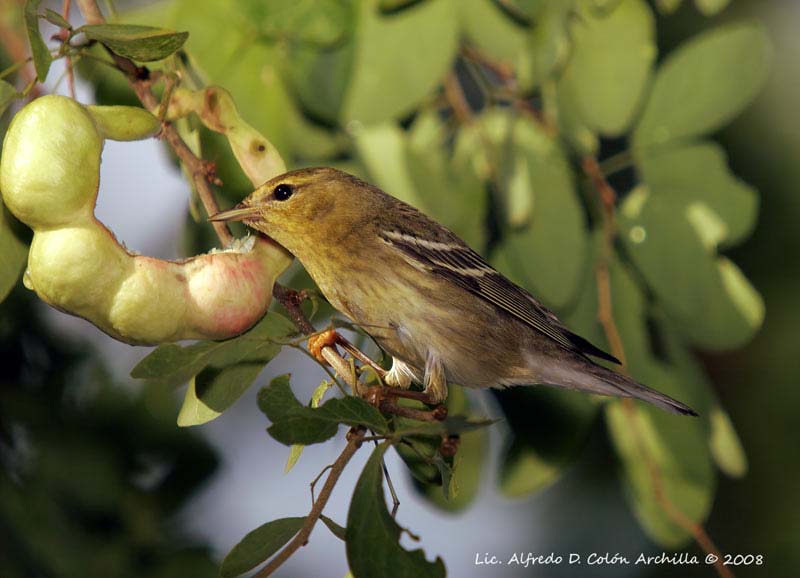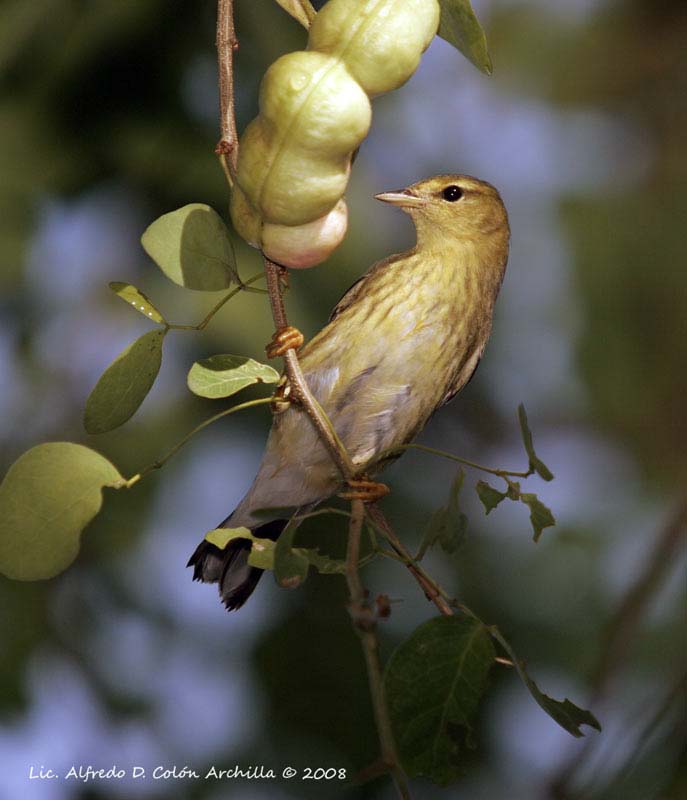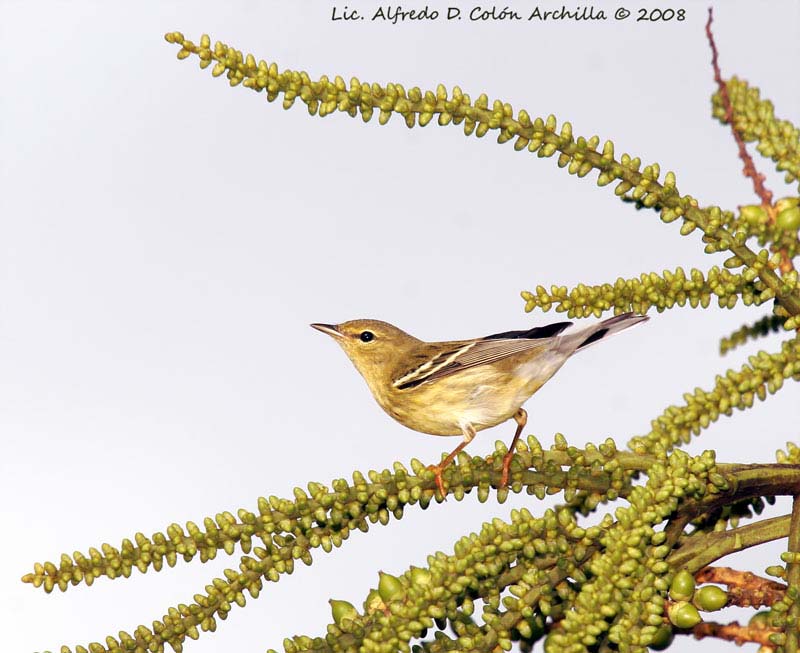
Blackpoll Warbler
Setophaga striata
Passeriforme Order - Parulidae Family
BIOMETRICS:
Length: 14 cm; Wingspan: 21 à 23 cm; Weight: 12 à 13 g
LONGEVITY: 4 years
DESCRIPTION:
Blackpoll Warbler is a relatively large, dull greyish-olive warbler in most plumages, with diffuse streaking on mantle and flanks of varying intensity. Dullest birds appear almost unstreaked. They show white patches when hovering.
Adult male in summer is heavily streaked black and white, including sides of breast and flanks. It has black crown and white throat, cheeks and ear-coverts.
Adult female has dark-streaked, greyish-green crown and ear-coverts, greyish-green tinge to mantle, whitish supercilium and dark eye-stripe (absent in male), and a very faint yellow tinge to underparts. It lacks black sides to throat.
Winter adults and 1st-winters are all very similar. The most strongly streaked birds are adult males, and most indistinctly streaked are 1st-years.
Bill is thin and pointed. Legs are usually pinkish or yellowish (but in some are darker and browner).
VOICE: SOUNDS BY XENO-CANTO
Blackpoll Warbler’s calls include a loud “smack”, a loud and hard “chip”, and a thin high “seet”. Song is an extremely high “sit-sit-sit-sit-sit…” increasing in volume before fading.
HABITAT:
Blackpoll Warbler breeds in northern coniferous forest, especially spruces, and including burnt areas, forest edges and stunted forest at the edge of the tundra. At other times, it is found in a broad range of woodlands, thickets and bushy areas.
RANGE: Blackpoll Warbler breeds from Alaska to Newfoundland, and southward to very north-eastern United States. It winters in South America, Chile, Brazil and Venezuela.
BEHAVIOUR:
Blackpoll Warbler is very active, constantly moving between trees and bushes, hovering and flycatching. Preys are usually gleaned from foliage or twigs. It also chases the insects and darts out into the air to snatch them with its bill. It has been observed eating nectar and /or pollen in winter.
Blackpoll Warbler is a migratory bird. It migrates at night. Scott Weidensaul (author of “Living on The Wind”) tell us about distance and time of migration: “it is about an 80 to 90 hours journey, during which they will beat their wings three or four millions times; they will have no rest, no food, no water. If they touch the water, they are dead. These birds are not waterproof, they can float. And yet it works.”
They perform a non stop flight of up to 2,175 miles, and 88 hours. The total trip may exceed 4,971 miles, from breeding grounds in Alaska to wintering grounds in Brazil.
FLIGHT:
Blackpoll Warbler has a very strong, rapid and bounding flight.
REPRODUCTION:
Blackpoll Warbler’s nest is a compact bulky open cup of twigs and lichens, lined with grasses, fine plant fibres, and gulls feathers. Nest is located in a small tree, arranged in a circular direction. It is concealed in forks of spruces or dwarf pines and is located from 3 to 15 feet above ground. Both sexes often return to the previous year’s territory, so re-pairing is common.
Female lays 3 to 5 white, buff or pale green eggs, with brown spots all over. Incubation lasts about 12 days, by female. Both parents feed the young at nest, and for two weeks after fledging. Chicks hatch helpless and fledge at 11 to 12 days, well before they are able to fly effectively.
This species produces one brood per year, occasionally two.
DIET:
Blackpoll Warbler feeds on insects, (aphids, beetles, mosquitoes, ants and wasps) and spiders. In migration and during winter, they consume some berries.
PROTECTION / THREATS / STATUS:
During night migrations, Blackpoll warblers are attracted to bright lights and collide with such obstacles as lighthouses, television towers and tall buildings. Acid rain and spraying budworm control could have adverse effects.
Populations are declining on the breeding range (Alaska 54% - British Columbia 91% - Quebec 91 % - Newfoundland 78 %) There are no obvious explanations for these declines.
Fr: Paruline rayée
Porto Rico : Reinita Rayada
All : Kappenwaldsänger
Esp : Chipe Estriado
Ital : Dendroica striata
Nd : Witwangzanger
Sd : Vitkindad skogssångare
Photographs by Alfredo Colón
Puerto Rico Wildlife
Sources:
THE HANDBOOK OF BIRD IDENTIFICATION FOR EUROPE AND THE WESTERN PALEARCTIC by Mark Beaman, Steve Madge - C.Helm - ISBN: 0713639601
FIELD GUIDE TO THE BIRDS OF NORTH AMERICA by National Geographic Society - National Geographic Society - ISBN: 0792274512
All About Birds (Cornell Lab of Ornithology)
Wikipedia (Wikipedia, The Free Encyclopedia)
What Bird-The ultimate Bird Guide (Mitchell Waite)
Birds of Nova Scotia (Robie Tufts)
Bird Web (Seattle Audubon Society)


